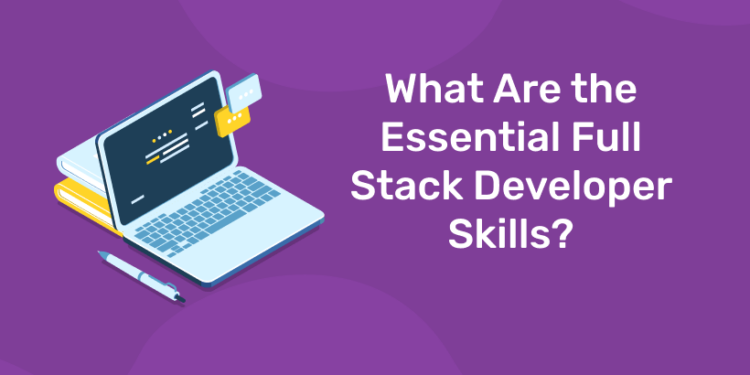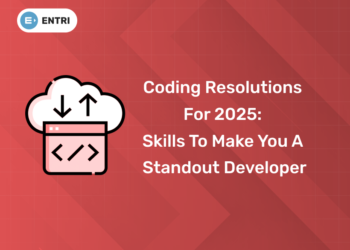Table of Contents
Learn to code from industry experts! Enroll here
Now, a Full Stack Developer is a software expert who’s equally proficient in frontend (client-side) development and backend (server-side) development. Full Stack Developers are familiar with each layer of tech stacks that go into the making of a software product. They know how each layer functions and, most importantly, can manipulate all the backend components.
Full Stack Developers have a broad skill set and extensive knowledge base. Thus, one needs years of experience in software development to earn the title of a Full Stack Developer. They are highly valued by large companies and small startups alike.
What are the crucial Full Stack Developer skills?
As we mentioned before, a Full Stack Developer boasts of a wide variety of skills. Here are Full Stack Developer skills that are non-negotiable!
1. HTML/CSS
While HTML stands for Hypertext Markup Language, CSS stands for Cascading Style Sheets. HTML is used for adding web content, and CSS is a personalization tool for designing and styling a website. Both HTML and CSS determine the look and feel of a website, which ultimately plays a major role in attracting prospective customers.
Full Stack Developers have to work with HTML to define the structure of web pages by using markup. They must also be proficient in CSS for effective presentation of the HTML elements. Full Stack Developers must have extensive knowledge in both of these programming languages for creating an interactive, intuitive, and engaging frontend for applications.
2. JavaScript
When it comes to web and software development, JavaScript is a mandatory Full Stack Developer skill. The object-oriented scripting language is mostly used for adding behaviors using HTML. It is one of the most widely used languages for writing frontend and backend code for servers. Furthermore, JavaScript is the only programming language that can run natively in the browser and on the server-side (Node.js).
Full Stack Developers must have in-depth knowledge of JavaScript along with its concepts and features like React and Angular. One of the best things about JavaScript is that it includes numerous useful features, including functions, prototypes, higher-order event delegation, and closure, which help create responsive web pages.
Learn to code from industry experts! Enroll here
3. Git and GitHub
Every developer, as well as aspiring developers, has heard of Git. It is an open-source “distributed version control system” that can handle all your development needs. It promises speed and efficiency for both small and large-scale projects. With Git, developers can seamlessly manage all the changes made to applications, codes, websites, documents, and other information associated with software/application development. Professional developers usually have a GitHub profile, which is compulsory if working in a team.
As for Full Stack Developers, Git allows them to track every minor modification done to the application codebase. They must be aware of all the basic Git commands and examples. Using Git empowers Full Stack Developers to explore unique opportunities for security, productivity, and management. Knowledge of Git allows Full Stack Developers to better collaborate and cooperate with their fellow developers/programmers who are working on the same project.
4. Backend languages
While we’ve covered the two most critical frontend languages, HTML and CSS (along with JavaScript), the other pivotal part of an application or software is the backend. While backend development is a whole different game, there’s plenty of programming languages to choose from. Doing a full stack web development course with placement will help you learn the required languages necessary to become a full stack developer.
A Full Stack Developer must know at least a few of these languages for backend development:
- PHP – One of the most popular choices for backend development, PHP is an open-source, cross-platform compatible language that can work seamlessly on Unix, macOS, and Windows.
- Python – Python’s English-like syntax, smooth learning curve, and a vast assortment of libraries and frameworks is what makes it extremely popular among developers and coders around the world.
- Ruby – Ruby is a robust programming language. An active community of developers backs it, but it also boasts of excellent documentation and dependencies, making it the ideal choice for backend development.
- Java – Java is a multipurpose programming language. It can be used for web, desktop, and mobile application development. Plus, Java has a wide range of frameworks that further simplify the process of backend development.
5. Web architecture
Full Stack Developers are the wizards of software development. They are equipped with multiple skills belonging to both frontend and backend development.
Full Stack Developers need to know the basics of web architecture. Since their primary responsibility is to develop complex software applications from scratch, they must know how to structure the code, categorize the files, structure the data in databases, and perform the necessary computational tasks.
6. HTTP and REST
Both HTTP and REST serve two unique purposes. HTTP is the protocol used for facilitating communication with the client, whereas REST is an interface between systems using the HTTP protocol to gather data or perform different operations (in various formats) on the data. So, REST acts like a translator between the frontend and the backend.
Since HTTP and REST are necessary for Full Stack development, Full Stack Developers must master both.
7. Database storage
All web applications need a database where all the data will be stored. This is to ensure that developers can access the data later. Database storage calls for an experienced and skilled Full Stack Developer who knows relational databases and database storage inside-out. Full-stack developers must be expert in database management – they should be able to design, understand, and manipulate database queries.
Things that a Full Stack Developer must know concerning database storage and management:
- Characteristics of relational/non-relational data.
- Knowledge of NoSQL databases.
- Knowledge of web storage.
8. Basic design skills
As we have made it clear that a Full Stack Developer is concerned with frontend and backend, they must possess the fundamental design skills. The knowledge of frontend design is crucial to make a website look attractive and appealing. A website with a neat and user-friendly design always wins the hearts of the users.
Thus, Full Stack Developers must know the basic design principles, including UI & UX design, prototypes, scalability, etc.
Learn to code from industry experts! Enroll here
9. NPM
NPM is the package manager explicitly designed for Node.js. It aids in the installation of different packages. It also offers relevant solutions for various dependencies. NPM allows developers to place modules optimally to help the node to find them and manage the dependency conflicts accordingly. NPM is highly configurable, and thus, it can be used for many applications, including the development, publishing, discovery, and installation of node programs.
10. Soft skills
When you aspire to become a Full Stack Developer, only technical skills won’t be enough. You must possess the perfect balance of technical knowledge and soft skills. Every Full Stack Developer must have the following soft skills:
- An analytical bent of mind
- Good time management skills
- Curiosity for learning
- Attention to detail
- Creative vision
- Patience
By learning some of these technologies and mastering the different programming languages, you will be able to become one of the full-stack web developers and earn as much as you need!
The following are the top 10 programming languages for web developers that you need:
1. JAVA
This is a simple and readable programming language that is commonly used in developing native Android apps. It is usually used for back end tech especially while dealing with complex applications. It is also able to operate on nearly all platforms such as Mac OS, Windows, UNIX, Solaris, Linux, among others. In addition, JAVA can be configured with a number of application servers. As a web developer, you need to learn how to programme using JAVA as you travel the landscape of web technology. In addition, because of JAVA’s stability and compatibility, it is suitable for large-scale projects, making it suitable for any project that you may have to undertake.
2. JAVASCRIPT
If your aim is to give your users a fantastic experience while making web pages as interactive as possible, JavaScript is the best programming language for you. This is a browser based programming language. If you need to add several effects to the web pages you create, or need to create pop-up messages on your website, then you need JavaScript. This language is also able to attract traffic of visitors to a website. It gives the web page an aesthetic look thereby creating a powerful visual effect. This is one front-end technology that a full-stack web developer should not ignore. All web developers need this programming language as it is the scripting language needed for the World Wide Web.
3. PHP
Hypertext Pre-processor (PHP) is a server-side scripting language that is commonly used by web developers. This means that it is able to build a database or manage data on a web server. It is a back-end technology that can be used to create web pages that have been written in HTML. PHP has high compatibility across many platforms and is an open source utility. As a full-stack web developer, you need PHP due to its being well supported by a large online community, and because it is one of the best when it comes to developing web-based applications. Additionally, it can be used in developing media and advertising apps.
4. RUBY
This is a dynamic programming language that offers a programmer friendly interface for development. It is also an object-oriented language, making it one of the best programming languages for those that would like to make creative designs. Ruby is used by several web developers because of the simplicity and the effectiveness of its writing techniques. It is easy to learn, and hence good for beginners. It is used mainly for developing web and mobile apps.
5. HTML
HyperText Markup Language (HTML) is a globally accepted standard markup language. If you need a tool for formatting web pages by giving them the best look and appearance, HTML is very useful. When used with JavaScript and Cascading Style Sheets (CSS), HTML gives the desired page layout of the web pages. Some of the best features of HTML are its syntax is simple, is easy to learn, is supported by all browsers and development tools, and it is search engine friendly.
6. Python
Python is a simple programming language that has a variety of features such as object-oriented programming, functional programming and structured programming. It is also a scripting language, meaning as a full-stack web developer, you will need this programming language especially when working on scientific, academic and research based applications. This is because Python offers prompt execution and can be used in mathematical calculations. In addition, it is incredibly good for beginners and can easily be used by hackers and cyber security experts.
7. Perl
Practical Extraction and Report Language (Perl) is an interpreted language and was developed by Larry Wall . As a full-stack web developer, Perl is recommended for text processing. It also combines most features of other programming languages. With its several frameworks such as Catalyst, Dancer and Mojolicious, and toolkits, Perl has the capability to make web development and deployment easier and simpler. Its ability to manage texts and glue systems makes it a great tool in web development.
8. Cascading Style Sheets (CSS)
Cascading Style Sheets (CSS) is a style sheet language used to describe the presentation of a document written in other languages especially HTML or XML. CSS enables one to have control of the web pages during their development. Some of the incredible features of CSS include; compatibility with every web browser, ability to produce web pages that can be customised and are print-friendly, and consistency of the web pages among other. There are several benefits of using CSS as a full-stack web developer.
9. SQL
Structured Query Language (SQL) is a special-purpose programming language used by web developers to access required data from databases. It is able to access and manage data in MySQL, Oracle, and Sybase among other database systems. This makes it appropriate for use on data-driven websites.
10. C++
This is a general purpose, object-oriented programming language that can be written in simple English language. It is a server-side web development language. The simplicity and portability of C++ makes it easy and efficient to use among programmers. As a full-stack web developer, C++ is appropriate because of the reusability of the codes and the high level performance.
There are several programming languages that full-stack web developers require. With the changing technological landscape, there is a need to learn as many languages as possible as there is no one language that is made to fit in all situations.
Conclusion
1: Which of the following is a JavaScript framework/library?
To conclude, Full Stack engineer are highly skilled experts who can handle everything related to web development. These Full Stack Developer skills are what distinguishes them from Frontend and Backend Developers.
Why doing a full stack developer course with placement will help?
- Structured learning
- 1 to 1 mentorship
- Job assistance
- Latest language and tools
- Career support and more.
If you’re interested to learn more about full-stack software development, pursuing a full stack web development course will help you master full-stack web development.
Are you a web-developer? Do you want to develop your tech-skills in web development? Have you specialized in front end and back end web development? Then you need to have the knowledge of several programming languages at your fingertips. Understanding web development is a process and a journey that begins by mastering simple techniques and continues as new trends in technologies set the stage.












